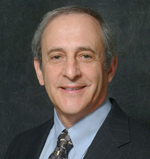September 2013

Richard J. Martin, MD
During his 40-year career, Richard J. Martin, MD, has become a fixture in Colorado in part because of his success as chair of the Department of Medicine at National Jewish Health in Denver—which he has grown from 50 to 145 faculty members and five lung-related divisions to 12 divisions that cover all aspects of medicine—but also because he can’t leave.
“About a year after arriving in Colorado, my wife said I can go anywhere I wanted, but she’s staying here,” Dr. Martin, 67, deadpans over the phone.
Dr. Martin is also a fixture in the respiratory community and ATS, which he joined in 1972. He’s served as a member on several committees, working groups, and on the editorial board of the American Journal of Respiratory and Critical Care Medicine. At National Jewish and the University of Colorado Denver, which he joined in 1980 after being recruited by Reuben M. Cherniack, MD, the “grandfather of pulmonary physiology,” he takes pride in mentoring faculty, fellows, and students—who have included ATS Immediate Past President Monica Kraft—and fostering a highly collaborative culture. “National Jewish is unique in that basic, translational, or clinical research is respected and treated equally,” Dr. Martin says. “We have clinicians asking questions that basic researchers take and try to answer and bring back to the patient. It’s truly from bench to bedside and bedside to bench.”
An authority in asthma research, Dr. Martin’s animal and human labs produced the study”A Link between Chronic Asthma and Chronic Infection,” published in the Journal of Allergy and Clinical Immunology in 2001. “It was the first to show a link between subacute bacterial infection and asthma,” he says. “The animal work shows how this propagates the inflammatory response particularly when there is an interaction between a bacterium and allergen.”
Additionally, his lab presented “Refractory Asthma: Importance of Bronchoscopy to Identify Phenotypes and Direct Therapy,” in CHEST in 2012. “Once we phenotyped these patients and directed therapy against that phenotype, their asthma greatly improved,” he says. “One of the phenotypes was this subacute bacterial infection.”
Dr. Martin oversees a multimillion-dollar AsthmaNet-National Heart, Lung, and Blood Institute grant and, he also receives a large private grant for his research project entitled “Identification of Molecular Biomarkers to Stratify Patients with Refractory Asthma.”
“Of Dr. Martin’s numerous contributions, one of the most significant is the observation that the lower airways of patients with asthma are not sterile, with up to 50 percent demonstrating evidence of colonization with atypical bacteria such as mycoplasma,” says E. Rand Sutherland, MD, MPH, chief of the Division of Pulmonary, Critical Care, and Sleep Medicine at National Jewish—one of Dr. Martin’s many mentees. “This finding set the stage for much of the current interest and research activity in the lung microbiome, both in health and disease.”
Indeed, “The Lung Microbiome: A New Frontier in Pulmonary Medicine” was the title of the 2013 Thomas L. Petty Aspen Lung Conference, 56th Annual Meeting, for which Dr. Martin served as chair. The packed hall agreed that the there is a microbiome within the lung, he notes. “Now the question is, ‘Is a normal lung microbiome good bacteria?’ We’re just scratching the surface,” Dr. Martin says, noting that this could potentially lead to procedures similar to fecal transplants to alter the microbiome to treat asthma and other diseases.
Dr. Martin earned his medical degree at the University of Michigan Medical School, and completed an internship at the Good Samaritan Hospital in Phoenix. After his residency at Tulane University in New Orleans, Dr. Martin studied under Robert M. Rogers, MD, during a fellowship at University of Oklahoma. “Bob was not only a mentor with regard to medicine and lung disease, but he and his wife, Sandy, were life mentors as well,” he says.
The chair of one of the nation’s leading respiratory hospitals wasn’t always fixated on lungs. He envisioned himself as being a family practitioner, like his own version of the 1970s TV doctor Marcus Welby. During his family practice internship at Good Samaritan Hospital, he was placed on a pulmonary rotation under Drs. Bernard E. Levine, Howard M. Kravetz, and Murray Spotnitz, where he encountered a patient hooked up to an MA-1 ventilator. “Seeing how machines could really change the outcome of a critical care patient was one of the most enlightening moments in my medical career,” says Dr. Martin, who was taught how to disassemble and reconstruct the ventilator—an impossible feat with today’s advanced technology. “Before that, my studies consisted of history, physicals, medicines, etc. Here was a life-saving intervention that could be undertaken.”
When not at the desk or bench, Dr. Martin spends time with his grown children and grandchild at their homes, on the world-renown ski slopes, hiking trails, or golf courses. And you can be sure—his wife, Helene, of 46 years will tell you—he’s not leaving Colorado anytime soon.
Life in ATS
ATS Member Since: 1972
Primary Assembly: Allergy Immunology & Inflammation
Dr. Martin has served as a member on several committees, working groups, and on the editorial board of the American Journal of Respiratory and Critical Care Medicine. “When I joined, the ATS was the premiere respiratory society, and it still is today,” he says.

